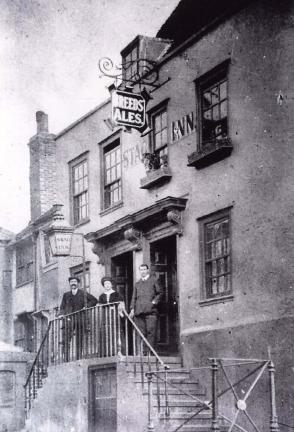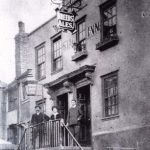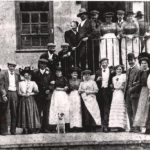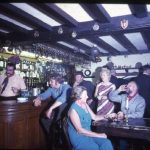ALL SAINTS STREET
By John Hodges
There is little doubt that All Saints Street now takes its name from the ancient parish church located at its northern end. Previous to this it had been described in old deeds as “The King’s Highwaye leading from the Pulpitt Gate to the Minness”. For a period between these two names, it was known as Fish, or Fisher Street after the calling of so many of those who lived there. Whilst All Saints Street most certainly provided the dwellings for many of the fishing community over the years, it also provided land for schools and perhaps after the Swan the most significant of the old coaching inns, The Crown. This was an ancient inn that once stood in Courthouse Street near the old Court Hall, but from the end of the eighteenth century occupied a large site stretching from All Saints Street up the hill that is now Crown Lane, as far as Tackleway. The Old Town of Hastings, and All Saints street in particular, was blessed with many ancient inns The Crown, The Cinque Ports, The George, an ancient Kings Head to name but a few. From about 1830 onwards these were supplemented with a significant number of beerhouses created under the somewhat liberal provisions of the Beerhouse Act of that year. These very basic premises, created by the simple purchase of an excise license costing two guineas, included several attractively named houses, The Hope of Freedom, The Fishermen’s Home, The Harbour Bar, The Alma, but all had disappeared within a few years of the turn of the new century.
One such inn, not a truly ancient one, with a licence granted in 1835 was The Stag, which since its first existence has attracted tales of smugglers , of secret passages and hidden treasure. And when blended with the flavour of Old Hastings conjures up visions of stormy nights and friendly haunts, probably more so than any of the Old Town’s other picturesque hostelries. The Stag, standing high on the eastern side of All Saints Street with its whitewashed walls and oak beams is so typical of the cottages that adorn this ancient street. Ornate wood carvings uncovered over the years indicate that part of the building dates back to at least Tudor times. The building has a wealth of oak beams, winding passages and stairways, cupboards that lead nowhere, and even a false facade. There are inglenook fireplaces, wide chimneys that could conceal a man, and a passage that ran to caves at the rear of All Saints’ churchyard. This accumulation of history and character no doubt prompted the old Ministry of Local Government in the 1950s to have the building listed as one of special architectural or historic interest.
Probably one of the most bizarre features of The Stag is the adornment of the bar by two mummified cats hanging from the oak beams. One tale that has emerged from the mists of time attributes the ownership of these felines to Hannah Clark, a legendary witch who supposedly lived above the fireplace in the pub. The remains of these unfortunate creatures were discovered just prior to the First World War during the building of a new fireplace, when they were “exhumed” and mounted aloft as a pair of petrified sentinels.
Legend tells us The Stag was once a haunt of smugglers. There is undoubtedly some element of truth in this nefarious association although some of the more tenuous claims must be regarded as supposition. However, in 1906 hidden treasure was discovered when an alteration to a ceiling in the bar uncovered a horde of spade guineas and Spanish doubloons, which were subsequently declared treasure trove resulting in a reward for the honest workmen who made the find.
From the earliest days the first landlords could have brewed their own beer on the premises, with local hops, malted barley, and water from the Bourne Stream. As other trades began to develop the art of brewing was not neglected, and by the early 17th century John Brett was the leading brewer, doubtless supplying to the many inns now trading in the area. The quality of this early beer was very much dependent upon the state of the Bourne stream, and it was not unknown for the Bailiff of the Bourne to place an order on the brewer instructing him under penalty not to take water from the stream below a certain point, owing to the fact that its contents had been supplemented with liquids other than water.
It is however more probable that the Stag took its beer from a local brewer, Amoores and Burfields were both brewing in nearby Courthouse Street, whilst Breeds were located even closer, with access to their brewery via the nearby Bourne Walk. In fact the first of the recognised brewers to own the Stag were Breeds and Co. of the Hastings Brewery, who supplied beers and stouts through to 1931, when they were acquired by George Beer and Rigden of Faversham. Fremlins bought control of Beer and Rigden in 1949, and in 1967 they in turn were taken over by the giant Whitbread group. Eventually The Stag formed part of a parcel of public houses that were disposed of by Whitbreads, and we r e bought by the current owners Shepherd Neame the Faversham brewer. The Stag has always had a good reputation for the quality of its beers, and at one time it could boast its own bottle of a special brew named “One flew over the Stag” . The “One” actually alluded to a spitfire, which featured in an advertising campaign that Shepherd Neame ran to celebrate the war time connection between this wonderful aircraft, and the counties of Kent and Sussex. But the ultimate accolade that this excellent public house received for the quality of its beers came in 1993 when it was voted CAMRA Sussex Pub of the Year. Today The Stag still trades as a pleasant hostelry very much part of the Old Town scene, but free of the tales of smugglers and witches and focussing only on the social needs of the many locals and tourists alike who are attracted by the pleasures of this picturesque inn.
Hastings Town November 2012
All articles, photographs and drawings on this web site are World Copyright Protected. No reproduction for publication without prior arrangement.



